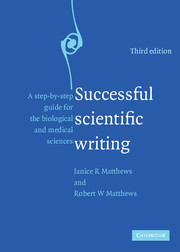Book contents
- Frontmatter
- Contents
- Preface
- Preface to the third edition
- 1 PREPARING TO WRITE
- 2 COMPOSING A FIRST DRAFT
- 3 VISUAL SUPPORT FOR THE WRITTEN WORD
- 4 VISUAL SUPPORT FOR THE SPOKEN WORD
- 5 REVISING TO INCREASE COHERENCE
- 6 IMPROVING WORD CHOICE, AND SYNTAX STYLE
- 7 ATTENDING TO GRAMMAR, NUMBERS, AND OTHER MECHANICS
- 8 THE REST OF THE STORY
- Appendix 1 Suggested responses to exercises
- Appendix 2 Excerpts from “Uniform requirements for manuscripts submitted to biomedical journals: Writing and editing for biomedical publication”
- Selected resources
- Index
2 - COMPOSING A FIRST DRAFT
- Frontmatter
- Contents
- Preface
- Preface to the third edition
- 1 PREPARING TO WRITE
- 2 COMPOSING A FIRST DRAFT
- 3 VISUAL SUPPORT FOR THE WRITTEN WORD
- 4 VISUAL SUPPORT FOR THE SPOKEN WORD
- 5 REVISING TO INCREASE COHERENCE
- 6 IMPROVING WORD CHOICE, AND SYNTAX STYLE
- 7 ATTENDING TO GRAMMAR, NUMBERS, AND OTHER MECHANICS
- 8 THE REST OF THE STORY
- Appendix 1 Suggested responses to exercises
- Appendix 2 Excerpts from “Uniform requirements for manuscripts submitted to biomedical journals: Writing and editing for biomedical publication”
- Selected resources
- Index
Summary
Writing is an adventure. To begin with, it is a toy and an amusement. Then it becomes a mistress, then it becomes a master, then it becomes a tyrant. The last phase is that just as you are about to be reconciled to your servitude, you kill the monster and fling him to the public.
– Winston ChurchillWriting is usually portrayed as hard, mindless, joyless work. Great authors, it is said, must suffer from a sort of “creative madness” and work in mindless binges under endless pressures of deadlines, exhaustion, and criticism. Writing is said to be stressful, unpleasant, and disliked. Yet, if this were really the sole route to successful writing, why would anyone choose it?
Yes, it is true that stress is associated with writing that is delayed and then forced under deadlines. However, there are more attractive and productive alternatives to writing in tedious, joyless ways. In this chapter we'll guide you along. We'll help you deal promptly with matters of authorship, both to minimize the potential for misunderstandings and to guide collaboration and any division of responsibility. Recommendations for ways to use word processing tools will help you write more proficiently, avoiding pitfalls while becoming adept at using efficiency-enhancing features. We'll show you how to ease the writing task by paying attention to standard format conventions. We'll share tips on ways to build your writing momentum and deal constructively with the dreaded writer's block.
- Type
- Chapter
- Information
- Successful Scientific WritingA Step-by-Step Guide for the Biological and Medical Sciences, pp. 31 - 55Publisher: Cambridge University PressPrint publication year: 2007
- 1
- Cited by



